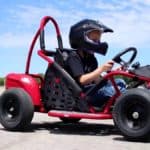Go-kart racing is a thrilling and fast-paced sport that is enjoyed by people of all ages and skill levels. However, it is also a sport that requires a certain level of knowledge and expertise to ensure a safe and enjoyable experience. In this article, we will be answering 22 essential questions that every go-kart driver should know the answer to.
From proper safety procedures to the best way to maintain your kart, these questions and answers are designed to give you the information you need to become a successful and confident go-kart driver. So, whether you’re a seasoned pro or starting out, this article is for you.
1. Does Weight Matter in Go-Karting?
In go-kart racing, weight does not matter in a competitive race. There is a weight limit rule in go-karting by which every kart, which includes the driver, must be the same weight. Before the race, every driver is weighed individually by the race official. Once they determine the heaviest driver, they assign the weight that every other driver needs to add to their kart to equalize their weight to the heaviest driver’s weight. This ensures a fair and equal race for all competitors.
2. Does Go-Karting Burn Calories?
Go-karting is a demanding sport that requires drivers to be in top shape. On average, go-kart drivers lose between 350 and 500 calories per hour while racing, depending on their body weight and the type of race they are in. This is because go-karting is a physically demanding sport that requires a lot of upper-body strength and endurance.
3. Do Racing Go-Karts Have Seat Belts?
Professional go-kart drivers do not wear seatbelts because the kart they are racing in is not safe enough to protect them in case of a crash. It is much safer to be thrown out of the go-kart than to be attached to it in case of a severe accident or a rollover.
If you want to read more, head over to Do Go Karts Have Seat Belts?
4. How Fast is the Fastest Go-Kart?
The fastest go-kart in the world belongs to Daymak C5 Blast, which can go from 0-60 mph in just 1.5 seconds. The Guinness world record for go-kart top speed is currently held by Tom Bagnall, from Cheadle, Staffordshire, UK, who achieved 112.29 mph (180.72 km/h) in York, the UK, on 5 September 2017 with Andy Morris’s custom-built go-kart.
5. Will a Lawnmower Engine Work on a Go-Kart?
Lawnmower engines are perfect replacement engines for go-karts. They are small, lightweight, and powerful. They can easily be adapted to work with a go-kart frame and offer a cost-effective solution for those looking to build their go-kart.
6. Can You Put a Motorcycle Engine on a Go-Kart?
You can add a motorcycle engine to a go-kart if the frame allows it. However, it is important to remember that motorcycle engines are much larger and heavier than lawnmower engines and may require additional modifications to the go-kart frame.
7. Do Go-Karts Have Suspension?
Go-karts are not suspended because it would go against the basic principle of go-karts: to be low to the ground and have exceptional cornering abilities. Suspension increases ground clearance, and additional brakes would be required at the back wheels, resulting in a loss of the ability for wheel jacking.
8. Do Go-Karts Have Gears?
Go-karts typically come with a single gear or a small number of gears. The gears are usually operated by a centrifugal clutch, which automatically shifts the gears based on the engine’s RPM. This means the driver does not have to manually shift gears while driving, making it a simpler and more intuitive driving experience.
9. Why is Driving a Go-Kart More Fun Than a Faster Car?
Driving a go-kart is more fun than driving a faster car because of its unique driving experience. Go-karts are smaller, lighter, and agile than cars, allowing for more precise and responsive handling. Additionally, the lack of a suspension system allows for more direct communication between the driver and the road, giving the driver a sense of being more connected to the driving experience.
Additionally, the speeds reached by go-karts are generally lower than that of cars, making the experience more accessible and less intimidating for new drivers.
10. How to Prepare a Go-Kart for Racing?
To prepare a go-kart for racing, you must ensure that it is in good working condition and that all components are properly adjusted and calibrated. You will need to check the tire pressure, alignment, and brakes and ensure the engine runs optimally. You should also check that the seat is correctly adjusted for your body size and that the steering wheel is centered.
Additionally, you should check that all safety equipment, such as helmets and safety harnesses, are in good condition and properly fitted. It is also important to practice and familiarize yourself with the track and the specific rules of the race before competing. Additionally, It is important to check the weight of the go-kart, driver, and other equipment you’re bringing to the race, as per the race’s regulations.
11. How Do I Choose the Right Go-Kart for Me?
When choosing a go-kart, consider what you will primarily use it for. A high-performance go-kart with a powerful engine would be best if you’re looking to race competitively. If you’re looking for something to use for recreation, a smaller, less powerful go-kart would be more suitable. Additionally, consider the go-kart size and ensure it’s comfortable for you to sit in and operate. It’s also important to check the weight capacity and ensure it can accommodate you and any passengers you plan on having.
12. What Safety Gear Do I Need for Go-Karting?
When go-karting, it’s important to wear safety gear to protect yourself in case of an accident. This includes a helmet, goggles or face shield, long sleeves and pants, racing shoes, and racing gloves. Some tracks may require additional gear, such as neck braces, fire-resistant go-kart racing suits, or arm restraints. It’s important to check with the track or facility you’ll be racing at to see their specific safety gear requirements.
13. How Do I Maintain My Go-Kart?
To keep your go-kart in good working condition, regular maintenance is necessary. This includes checking and changing the oil, checking and tightening bolts and fasteners, and checking the air filter. It’s also important to keep the go-kart clean and debris-free and inspect the tires and brakes regularly. Additionally, if you’re using a gas-powered go-kart, keep the fuel fresh and add a stabilizer if the go-kart will be in storage for an extended period.
14. Can I Race My Go-Kart on Public Roads?
No, it is not legal to race go-karts on public roads. Go-karts are not street-legal vehicles and should only be operated on designated tracks or private property with permission. Racing on public roads is extremely dangerous and puts drivers and other individuals at risk.
There are ways to make a go-kart street legal; you can even buy a legal go-kart; it’s up to you.
15. What is the Difference Between Gas and Electric Go-Karts?
Gas-powered go-karts have internal combustion engines that run on gasoline, while electric go-karts run on batteries. Gas-powered go-karts are more powerful and have a longer range, but they also require more maintenance and produce emissions. Electric go-karts are quieter, require less maintenance, and produce zero emissions, but they have a shorter range and may not be as powerful as gas-powered go-karts.
16. How Do I Get Started in Competitive Go-Kart Racing?
Find a local track or racing league near you to get started in competitive go-kart racing and inquire about their beginner classes or training programs. These programs will give you the necessary knowledge and skills to race safely and competently. Additionally, consider purchasing or renting a high-performance go-kart and participating in practice sessions to improve your driving skills.
17. Can I Modify My Go-Kart for More Speed and Performance?
Yes, you can modify your go-kart for more speed and performance. However, it’s important to check with the track or racing league you plan on participating in to see what modifications are allowed. Common modifications include upgrading the engine, adding performance parts such as a high-performance air filter or exhaust system, and adjusting the suspension.
I have a full guide on modifying a go-kart if you want to learn more.
18. What Are the Different Types of Go-Karts?
There are several types of go-karts, including recreational go-karts, racing go-karts, off-road go-karts, and electric go-karts. Recreational go-karts are designed for fun and leisurely use while racing go-karts are built for speed and performance on the track. Off-road go-karts are made for rough terrain and can handle tougher conditions than recreational go-karts. Batteries power electric go-karts and produce zero emissions.
19. How Do I Practice and Improve My Go-Karting Skills?
You can start by participating in practice sessions at a local track to improve your go-karting skills. Additionally, you can try different driving techniques, such as braking and go-kart cornering, to find what works best for you. Consider taking a go-kart racing class or working with a coach to learn advanced techniques and strategies.
20. What Are the Rules and Regulations for Go-Kart Racing?
The rules and regulations for go-kart racing vary by track and racing league. Common rules include guidelines for safety gear, vehicle modifications, and on-track behavior. It’s important to familiarize yourself with the specific rules and regulations of the track or league you plan on racing in to ensure compliance.
Related Article: Do Go-Kart Races Have Pit Stops?
21. What Are the Best Tires for Go-Kart Racing?
The best tires for go-kart racing are typically racing slicks designed to provide maximum grip on the track. These tires are made from a soft compound and have a smooth tread pattern, allowing optimal traction and speed. Other popular options include rain and intermediate tires, designed for wet or changing track conditions.
22. How Does the Weather Affect Go-Kart Racing?
Weather can significantly affect go-kart racing as it can change the track conditions and the tires’ grip. When go-karting in wet weather, the track becomes more slippery, making it more challenging to maintain control of the go-kart. The track can become slick and dusty in dry and hot weather, reducing traction.
High wind or gusts can make it more challenging to control the go-kart. It’s essential to know the weather conditions and adjust your driving accordingly.
Conclusion
In conclusion, go-kart racing is a fun and exciting sport requiring knowledge and expertise to ensure a safe and enjoyable experience. By understanding the answers to the 22 essential questions outlined in this article, you will be well on your way to becoming a successful and confident go-kart driver.
From proper safety procedures to the best way to maintain your kart, this guide has provided the information you need to make the most out of your go-kart racing experience. Remember always to prioritize safety and to have fun on the track. Happy racing!

Goran, an experienced go-kart racer, fuels GoKartLife.com with his passion and expertise. He offers valuable insights and tips for fellow enthusiasts, fostering the growth of the go-kart community. Join Goran at GoKartLife.com and immerse yourself in this exhilarating sport.
Last modified: December 11, 2024



